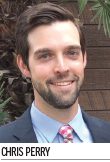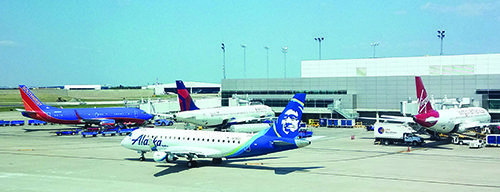The central location of Dallas Love Field (DAL)—just seven miles northwest of the downtown business district—is a double-edged sword. While ultra-convenient for travelers, the airport is surrounded on nearly all sides by residential developments, which presents myriad challenges when it comes to “keeping the peace.”
The city of Dallas, which owns and operates DAL, is committed to being a good neighbor while also maximizing the economic performance of the airport. To complement its voluntary noise control program, the city is investing more than $1/2 million to upgrade DAL’s existing noise monitoring system. Crews are scheduled to install new equipment by the end of this year.
The city council approved the purchase/implementation of a new noise monitoring system in January. The $502,696 investment is funded through the city’s general operating funds and includes a five-year service contract, notes Chris Perry, communications manager for DAL.
|
facts&figures Project: Noise Monitoring Location: Dallas Love Field Owner/Operator: City of Dallas Cost: $502,696 (includes purchase/installation of noise monitors & 5-yr maintenance contract Scheduled Completion: End of 2018 Noise Monitors: Larson Davis, a division of PCB Piezotronics Flight Tracking System: Casper |
Environmental Operations Manager Paul Mehrlich explains that noise monitors were originally installed at DAL in the 1990s to facilitate mapping airfield noise contours. Since then, modeling has changed and technology has improved, so the data gathered by the original monitors was not being utilized as much. “It just became kind of a check,” explains Mehrlich. “After they would do the model, they would go back and make sure that nothing looked strange.”
Upgrading the noise monitors will help DAL’s noise program remain transparent to the community, because citizens can access the data directly, without worrying that the airport is “filtering something out,” he notes.
“The community has definitely had an interest in what goes on here because of the Wright Amendment,” Mehrlich remarks. The Wright Amendment restricted operations for all airlines at DAL, but significantly affected Southwest Airlines, the airport’s predominant carrier. In October 2014, the Wright Amendment was repealed and replaced with the Five Party Agreement, which limited DAL to 20 gates and banned international commercial flights.
Much to everyone’s surprise, traffic volume at DAL has increased substantially following the repeal of the Wright Amendment, Mehrlich reports. In 2013, the airport served 4.2 million passengers; in 2017, it served 7.9 million.
Not surprisingly, community members took notice of the increased air traffic. “For them, it’s a drastic change,” Mehrlich acknowledges. Airport and city officials are consequently making extra efforts to stay engaged and involved in the community. Their main objective is to explain that despite the recent traffic increases, the number of gates at DAL is limited, and there will not be further growth.
Initially, noise complaints increased, and the airport stepped up its efforts to educate the community about the airport’s role and “make it simple for them to get answers up front.” DAL’s community outreach program is designed to make sure its neighbors are informed. “We found that as long as we stay ahead of it, they don’t feel like we’re hiding anything, and we’ve actually seen a decrease in noise complaints now,” Mehrlich reports.
Tech Upgrade
The 13 existing TA-40001 Noise Monitoring Stations will be removed and replaced with four Larson Davis 831-NMS noise monitors. The new monitors will be located off the ends of the main 8,800-foot runway to provide the most useful noise information. Deployment should not impact flight operations, as the monitors will be placed about 1,000 feet off the ends of Runway 13R-31L.
 The airport considered the use of portable noise monitors for added flexibility, but ultimately determined stationary monitors would provide more benefits.
The airport considered the use of portable noise monitors for added flexibility, but ultimately determined stationary monitors would provide more benefits.
The new Larson Davis 831s will provide data to the airport’s web-based flight tracking system in near-real time, says Mehrlich. The solar-powered units feature remote calibration checks and leverage cellphone-based technology. Airport officials were especially interested in a product that uses cellular phone technology, as opposed to the previous system which relied on hard phone lines. “We had a lot of problems with static,” Mehrlich recalls.
It was also important for the noise monitors to be solar-powered, he adds. In addition to being more environmentally friendly, solar power will provide operational reliability during a power outage.
Tracking Builds Trust
The core of DAL’s noise program is flight tracking. “We are constantly trying to make sure flight tracking is more accurate and that more information can be provided to the community,” Mehrlich relates. “We found by being completely open and honest with the community and providing more than they ask helps create trust. We care about what they’re worried about, and we’re sharing with them everything we know.”
 The new noise and operations monitoring system, by Casper, includes a public portal that provides flight tracking and noise data in Spanish and English. It is also optimized to allow community members to file complaints through their cellphones.
The new noise and operations monitoring system, by Casper, includes a public portal that provides flight tracking and noise data in Spanish and English. It is also optimized to allow community members to file complaints through their cellphones.
One of the biggest requirements for the new system was speed—specifically, the ability to disseminate noise data to the public as quickly as possible. The previous system took noise measurements and then performed a daily “data dump” that was not accessible until the following day. “Because of that, if a community member had questions, we weren’t able to use the current data, because we couldn’t see it yet,” Mehrlich notes. Having access to noise data in near real-time will provide the community with more information and expedite noise investigations when necessary.
“Some community members are trying to see if they can find something out of the ordinary,” Mehrlich explains, noting that reactions to aircraft noise vary from person to person. “When something comes over their house and they notice it, they want to figure out why.”
 In October, DAL will add Noise Lab, which allows community members to run reports about flight statistics themselves. The system, also from Casper, displays the number of flights using optimal departure procedure, automatically generates charts and graphs, shows departure and arrival routes, and displays flight track concentrations and noise contours.
In October, DAL will add Noise Lab, which allows community members to run reports about flight statistics themselves. The system, also from Casper, displays the number of flights using optimal departure procedure, automatically generates charts and graphs, shows departure and arrival routes, and displays flight track concentrations and noise contours.
Noise data is a tool that helps the community stay informed, Mehrlich emphasizes. Whether it’s a difference in flight pattern, aircraft or time of day, airport neighbors are often interested in figuring out why they noticed a particular flight. The combination of Noise Lab and the Complaint Management Module allows community members to make a noise inquiry by clicking on a specific aircraft.
Proactive Efforts
In addition to leveraging technology and equipment, DAL follows a Voluntary Noise Control Program to minimize the impact of aircraft operations on surrounding neighborhoods without restricting use of the airfield. Developed with the participation of airport officials, neighborhood representatives, the city of Dallas and FAA, the program includes:
• a preferential nighttime runway (13R-31L) for all jets and any aircraft weighing more than 12,500 pounds to use between 9 p.m. and 6 a.m.
• noise abatement departure procedures for night operations on Runway 13R for all turbojet aircraft and aircraft weighing more than 12,500 pounds
• prohibition of aircraft engine run-ups by maintenance staff from 10 p.m. to 6 a.m. (expanded from midnight);
• the use of optimal take-off profiles; and
• phone and online options for reporting noise complaints.
The Love Field Environmental Advisory Committee, which includes representation from the airport, airlines, FAA and surrounding neighborhoods, meets quarterly to review operations reports and provide information about upcoming airport projects. This helps keep everyone informed and allows feedback, explains Mehrlich. Given the demographics of surrounding neighborhoods, the airport presents its entire program in English and Spanish.



